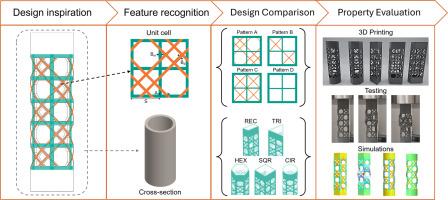Sea sponge-inspired designs enhance mechanical properties of tubular lattices
IF 7.1
1区 工程技术
Q1 ENGINEERING, MECHANICAL
International Journal of Mechanical Sciences
Pub Date : 2024-11-03
DOI:10.1016/j.ijmecsci.2024.109815
引用次数: 0
Abstract
The sea glass sponge, a marine organism with a distinctive tubular lattice skeleton, offers inspiration for developing resilient structures with exceptional buckling resistance. Previous work on sponge lattices focuses on mimicking the diagonal feature of the sponge unit cell; however, current understanding on the effects of the tubular three-dimensional arrangement seen in glass sponges is incomplete. This study seeks to leverage the benefits of sea glass sponge structures to enhance the performance of three-dimensional tubular lattices with improved compressive strength and elastic energy absorption. Through a combination of experimental and simulation techniques, we systematically examine the influence of varying cross-sectional shape and geometry of three-dimensional tubular lattice structures. Our experimental findings reveal that the sponge-inspired pattern surpasses all unit cell designs under compression loads. Sponge designs with a hexagonal cross-section exhibit the highest buckling strength, with a 74.9 % improvement over the non-reinforced design and a 39.0 % improvement within sponge designs. Meanwhile, the sponge designs with a circular cross-section show the best energy absorption, achieving a 90.8 % improvement over the non-reinforced design and a 54.0 % increase within sponge designs. Computational results show this novel design achieves improved stress distribution and stability due to the self-reinforcement of the struts’ orientation and reduction of stress concentration at sharp corners, which helps explain these findings. This study motivates the design of sea glass sponge structures for applications such as aerospace, marine, and infrastructure that requires high strength-to-weight ratio and buckling resistance.

受海棉启发的设计可增强管状晶格的机械性能
海玻璃海绵是一种具有独特管状晶格骨架的海洋生物,它为开发具有优异抗弯曲性能的弹性结构提供了灵感。以前有关海绵晶格的研究主要集中在模仿海绵单元格的对角线特征上;然而,目前对玻璃海绵中管状三维排列效果的了解还不全面。本研究旨在利用海玻璃海绵结构的优势,提高三维管状晶格的性能,从而改善抗压强度和弹性能量吸收。通过实验和模拟技术的结合,我们系统地研究了三维管状晶格结构截面形状和几何形状变化的影响。我们的实验结果表明,受海绵启发的图案在压缩载荷下超越了所有的单元格设计。横截面为六边形的海绵设计显示出最高的屈曲强度,与非加固设计相比提高了 74.9%,在海绵设计中提高了 39.0%。同时,圆形横截面的海绵设计具有最佳的能量吸收能力,与非加固设计相比提高了 90.8%,在海绵设计中提高了 54.0%。计算结果表明,由于支柱方向的自加固和锐角处应力集中的减少,这种新型设计改善了应力分布和稳定性,这有助于解释这些发现。这项研究推动了海玻璃海绵结构在航空航天、海洋和基础设施等需要高强度重量比和抗弯强度的应用领域的设计。
本文章由计算机程序翻译,如有差异,请以英文原文为准。
求助全文
约1分钟内获得全文
求助全文
来源期刊

International Journal of Mechanical Sciences
工程技术-工程:机械
CiteScore
12.80
自引率
17.80%
发文量
769
审稿时长
19 days
期刊介绍:
The International Journal of Mechanical Sciences (IJMS) serves as a global platform for the publication and dissemination of original research that contributes to a deeper scientific understanding of the fundamental disciplines within mechanical, civil, and material engineering.
The primary focus of IJMS is to showcase innovative and ground-breaking work that utilizes analytical and computational modeling techniques, such as Finite Element Method (FEM), Boundary Element Method (BEM), and mesh-free methods, among others. These modeling methods are applied to diverse fields including rigid-body mechanics (e.g., dynamics, vibration, stability), structural mechanics, metal forming, advanced materials (e.g., metals, composites, cellular, smart) behavior and applications, impact mechanics, strain localization, and other nonlinear effects (e.g., large deflections, plasticity, fracture).
Additionally, IJMS covers the realms of fluid mechanics (both external and internal flows), tribology, thermodynamics, and materials processing. These subjects collectively form the core of the journal's content.
In summary, IJMS provides a prestigious platform for researchers to present their original contributions, shedding light on analytical and computational modeling methods in various areas of mechanical engineering, as well as exploring the behavior and application of advanced materials, fluid mechanics, thermodynamics, and materials processing.
 求助内容:
求助内容: 应助结果提醒方式:
应助结果提醒方式:


